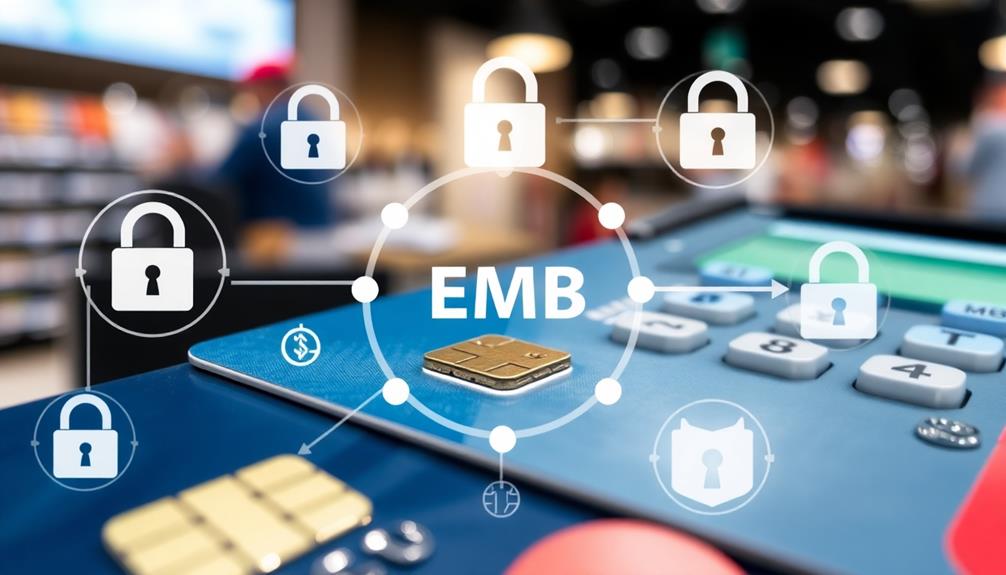EMV chip technology enhances your payment security by generating a unique transaction code for every purchase. This makes stolen card information almost useless for fraudsters. The embedded microprocessor chip also encrypts sensitive data during transmission, ensuring your information stays safe. Plus, the requirement for your physical card presence during transactions helps reduce the risks associated with in-store fraud. Since its adoption, the U.S. has seen a 58% drop in counterfeit fraud incidents, showcasing its effectiveness. As this technology evolves, you'll discover even more benefits and innovations on the horizon.
Key Takeaways
- EMV chips generate unique transaction codes for each purchase, preventing the reuse of stolen card data, enhancing overall security.
- The technology utilizes dynamic data encryption, securing sensitive information during transactions and minimizing interception risks.
- EMV requires the physical presence of the card, significantly mitigating risks associated with in-store fraud.
- Adoption of EMV has led to a 58% decrease in counterfeit fraud incidents in the U.S., showcasing its effectiveness.
- Enhanced security measures shift liability for fraudulent transactions to card issuers, fostering greater trust among consumers.
What Is EMV Technology?
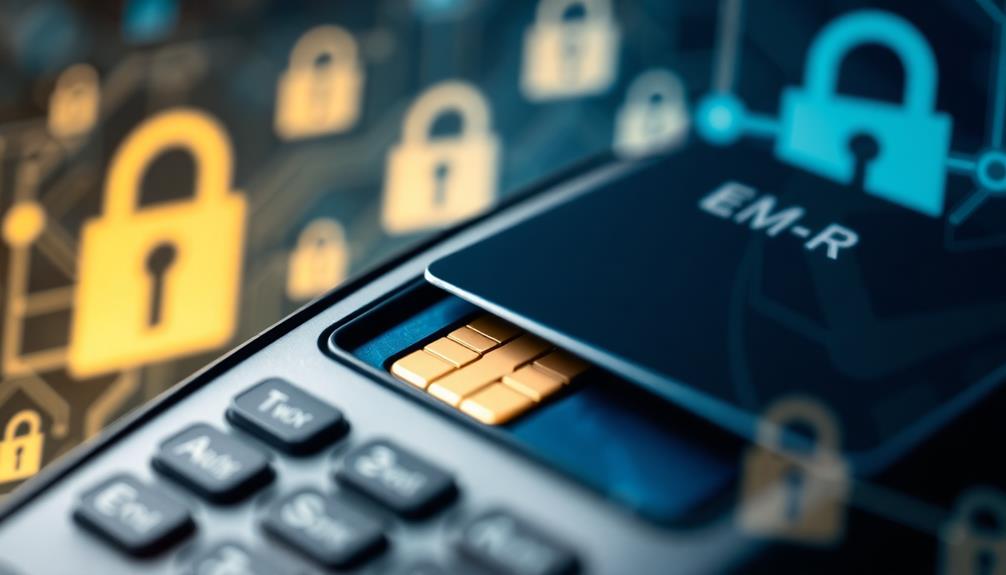
EMV technology, short for Europay, Mastercard, and Visa, revolutionizes the way we make secure transactions with credit and debit cards. This advanced payment security system incorporates embedded microprocessor chips in EMV cards, enhancing transaction security considerably. Each time you use an EMV card, it generates a unique transaction code, making stolen card information nearly useless for fraudsters. This technology aligns with the principles of accountability in personal finance, as it guarantees that only authorized users can complete transactions.
The primary goal of EMV technology is fraud prevention, particularly against card-present fraud and counterfeit fraud. By requiring the physical presence of the card during transactions, this technology mitigates risks associated with in-store fraud. Since the adoption of EMV cards, the U.S. has seen a remarkable reduction in counterfeit fraud incidents, dropping by approximately 58%.
With over 13 billion EMV cards now in circulation worldwide, it's clear that consumers and merchants alike have embraced this secure payment standard. EMV technology not only enhances transaction security but also builds trust among users, helping to create a safer environment for financial transactions.
Security Features of EMV Chips

The security features of EMV chips play an essential role in protecting your transactions from fraud. One of the standout elements is their ability to generate unique transaction codes for each purchase. This makes it nearly impossible for stolen card data to be reused or cloned, greatly reducing counterfeit fraud.
Additionally, EMV chips utilize dynamic data encryption, which scrambles sensitive information during transmission, ensuring that only authorized financial institutions can decipher the data. The integration of advanced AI enhances threat detection mechanisms further bolsters the security environment for electronic payments.
Another important feature is the requirement for physical card presence during transactions. This helps mitigate in-store fraud by ensuring that stolen card information can't be used without the actual card.
The complexity of EMV chip technology adds another layer of protection; it's difficult and costly for fraudsters to replicate or tamper with these chips, providing a robust defense against card fraud.
Since the adoption of EMV technology in the U.S., there's been a reported 58% decrease in counterfeit fraud, highlighting its effectiveness in improving payment security.
These features work together to protect your financial transactions and contribute to the recovery of stolen data, ensuring a safer shopping experience.
Benefits of EMV for Merchants
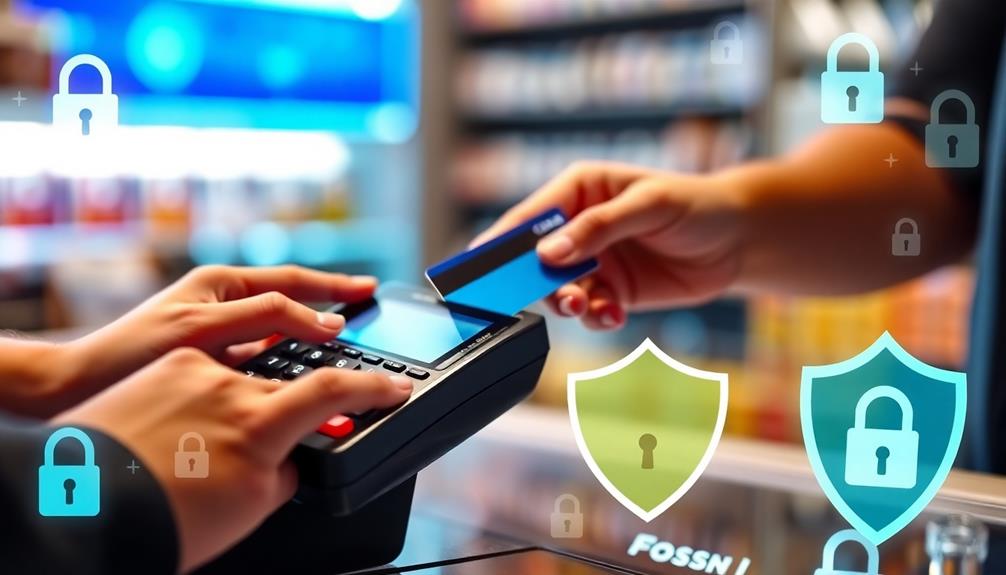
Merchants embracing EMV technology enjoy a range of significant benefits that enhance their operations and bottom line. One of the most compelling advantages is the substantial reduction in payment fraud, particularly counterfeit card fraud. In fact, Visa reported a 58% decrease in these incidents following EMV adoption in the U.S.
Additionally, with over 1.8 billion payment card records compromised in 2020, implementing robust security measures is more essential than ever. This enhanced security not only protects your revenue but also shifts liability for fraudulent transactions from you to the card issuers when customers use chip-enabled cards.
By supporting EMV payments, you can foster greater customer trust. Shoppers feel more secure knowing their cardholder information is better protected, leading to increased confidence during in-store transactions.
Furthermore, EMV compliance is vital to avoid fines and penalties; non-compliance may lead to significant financial repercussions under the liability shift guidelines established in 2015.
Ultimately, adopting EMV technology translates to long-term cost savings due to reduced fraud-related losses. By investing in this merchant service, you're not just improving security; you're also reinforcing your business's reputation while enhancing the overall customer experience.
EMV adoption is a strategic move that pays off in both security and profitability.
Adoption and Compliance Timeline

Since the change to EMV technology started back in 2011, retailers have faced increasing pressure to adopt these secure payment systems. The introduction of liability shift rules in October 2015 intensified this urgency, making merchants responsible for counterfeit fraud if they hadn't implemented EMV-compliant systems. This change signaled a notable turning point, prompting many to prioritize payment security.
Regular monitoring of compliance with these standards is essential for effective risk management, as it can greatly influence overall financial performance and mitigate potential losses related to fraud improved decision-making.
By 2019, over 3.7 million merchants had adopted EMV technology, showcasing the widespread compliance across the retail sector. The shift not only improved transaction security but also led to a remarkable 58% decrease in counterfeit fraud incidents, as reported by the Federal Reserve.
However, it's important to recognize that non-compliance with EMV standards can result in financial penalties, reinforcing the importance of timely adoption. As countries worldwide continue to mandate EMV-enabled cards, the technology's role in combating payment fraud becomes increasingly vital.
Embracing EMV isn't just about compliance; it's about protecting your business and customers from fraud, while enhancing overall payment security in a rapidly evolving digital landscape.
Equipment Needed for EMV Transactions
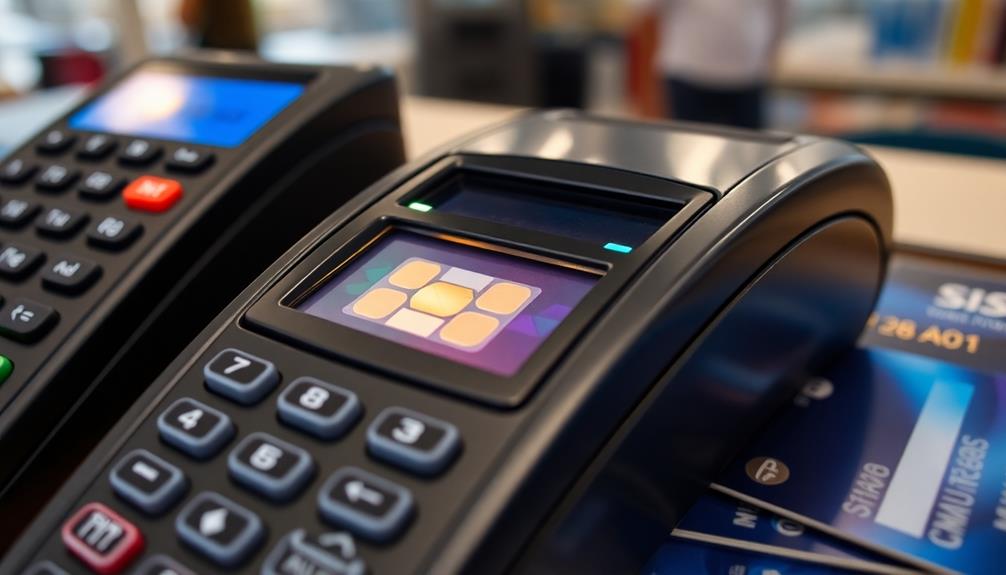
To process EMV transactions, you need EMV-compatible card readers that can securely read the chips embedded in cards.
Incorporating advanced security measures, such as boosting card payment security, is essential to protect sensitive customer information.
Consider incorporating contactless payment solutions for faster transactions and mobile payment devices for on-the-go acceptance.
Ensuring your equipment meets PCI compliance is vital for protecting sensitive customer information.
EMV-Compatible Card Readers
When processing EMV transactions, having the right equipment is essential, as EMV-compatible card readers are designed specifically to read the embedded microprocessor chips on chip-enabled cards.
These card readers not only enhance transaction security but also accommodate various payment methods, including magnetic stripe cards and contactless payments. This versatility is significant for merchants aiming to provide a seamless payment experience and mitigate risks associated with identifying and managing risks in merchant services.
Investing in certified EMV-compatible card readers is critical for compliance with liability rules established in October 2015. These rules shifted the responsibility for fraudulent transactions to merchants who fail to adopt EMV technology.
By utilizing EMV technology, you protect your business from potential losses associated with fraud.
The rapid adoption of EMV-compatible equipment has seen over 3.7 million merchants in the U.S. accepting chip cards by 2019. This trend reflects a significant commitment to improving payment processing systems and ensuring transaction security.
Additionally, portable solutions like Clover Go allow businesses to process secure chip-enabled transactions in various environments, enhancing flexibility and customer convenience.
Embracing EMV-compatible card readers is a smart move for any merchant looking to enhance payment security and streamline operations.
Contactless Payment Solutions
In recent years, contactless payment solutions have transformed the way consumers make transactions, offering a quick and convenient method to pay. Utilizing NFC technology, you can simply tap your EMV chip-embedded card or mobile wallet on an EMV-compatible terminal to complete your purchase. This approach enhances your shopping experience, minimizing waiting times and making payments more efficient.
Additionally, the rise of air quality concerns has led to an increased demand for products that improve indoor environments, much like how contactless payments enhance the shopping experience.
For merchants, having an EMV-compatible credit card machine is essential. These devices support both traditional magnetic stripe transactions and contactless payment methods, ensuring versatility in payment options. Many modern EMV readers come equipped with integrated contactless technology, allowing seamless acceptance of various payment methods, including mobile wallets.
Portable solutions, like Clover Go, provide small businesses with the ability to accept contactless payments on-the-go, enhancing flexibility for mobile transactions.
With the rapid adoption of contactless payment solutions—41% of in-store transactions in the U.S. used them by 2020—it's clear that consumers appreciate the convenience and secure payment methods offered by EMV Chip Technology.
Additionally, contactless transactions provide enhanced fraud protection, making them a reliable choice for both shoppers and merchants alike.
Mobile Payment Devices
As businesses increasingly embrace EMV chip technology, having the right mobile payment devices becomes essential for processing secure transactions. These devices, like Clover Go, are designed to accept EMV chip cards, ensuring card security and compliance with liability rules established in 2015. This protects you from potential fraud-related costs.
Most EMV-compatible mobile payment solutions also include magnetic stripe readers and NFC technology for contactless payments. This integration enhances transaction flexibility, allowing small and medium-sized enterprises (SMEs) to accept payments anywhere, increasing customer convenience. The adoption of EMV-enabled devices has considerably boosted consumer confidence during transactions, making it easier for you to grow your business.
Here's a quick overview of key mobile payment devices:
| Device Type | Features |
|---|---|
| EMV Chip Reader | Accepts EMV chip cards |
| Magnetic Stripe Reader | Reads traditional cards |
| NFC Technology | Enables contactless payments |
Incorporating these mobile payment devices into your operations not only streamlines the checkout process but also enhances the overall security of every transaction, fostering trust with your customers.
Future Innovations in EMV Technology
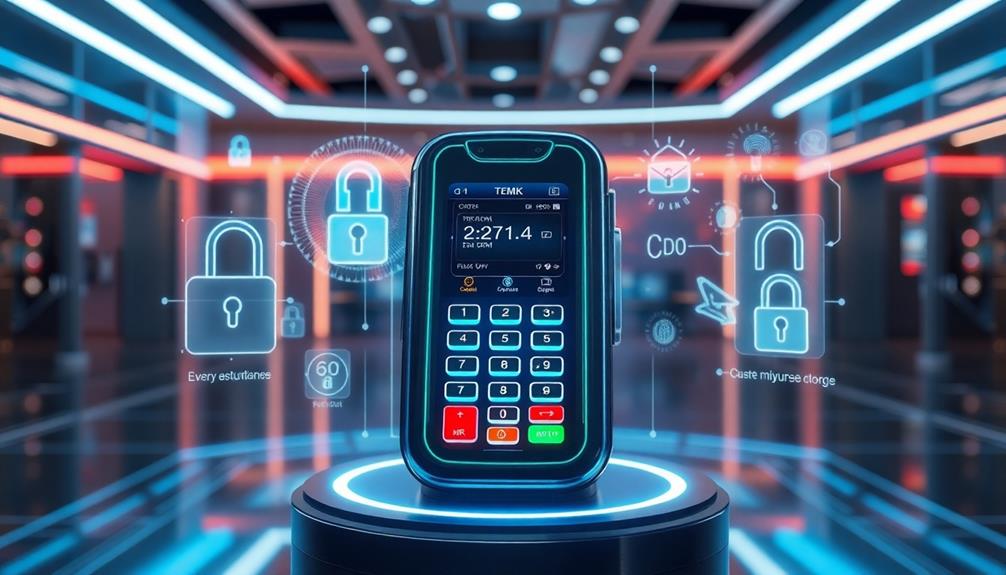
The future of EMV technology promises exciting innovations that aim to elevate security and convenience in payments. One major advancement is the integration of biometric authentication, allowing you to verify your identity through unique physical traits like fingerprints or facial recognition. This not only enhances security but also streamlines the checkout process.
As businesses increasingly adopt free SEO keywords acquisition strategies to improve their online presence, they'll also be seeking secure payment solutions that integrate seamlessly with their digital ecosystems.
As contactless payments gain popularity, adapting EMV standards to cater to these methods will be essential in the digital economy. This shift will meet the growing demand for faster transactions while ensuring that security remains a priority.
Global standardization efforts are underway to facilitate secure international transactions, simplifying cross-border commerce for both merchants and consumers.
To combat evolving security threats, continuous collaboration within the payments industry is essential. Future EMV innovations will likely feature enhanced encryption techniques and secure communication protocols, which will fortify transactions against data breaches and unauthorized access.
With these advancements, EMV technology will play a pivotal role in fraud prevention, ensuring that you can transact with confidence in an increasingly interconnected world.
EMV and Digital Payment Solutions

EMV technology greatly enhances digital payment solutions by delivering robust security measures that protect your transactions. With its unique transaction codes, the EMV chip greatly reduces the risk of credit card fraud and counterfeit fraud, providing peace of mind for both you and your customers.
Additionally, incorporating advanced technologies, such as Bitcoin IRA tax hacks, can further enhance security in digital financial transactions. Here are some ways EMV enhances the security of digital payments:
- Unique transaction codes: Each transaction generates a unique code, making it difficult for fraudsters to replicate.
- Encryption of card information: Your sensitive data is encrypted during transactions, reducing the chances of interception.
- Decrease in counterfeit fraud: EMV payments have led to a 58% drop in counterfeit fraud incidents.
- Technology adoption: Over 3.7 million merchants in the U.S. now accept EMV chip cards, demonstrating widespread acceptance.
- Integration of contactless payments: EMV standards allow for seamless mobile and contactless payment options, enhancing customer convenience.
Frequently Asked Questions
Why Are EMV Payments More Secure?
EMV payments are more secure because they use unique transaction codes for each purchase, making it tough for thieves to reuse stolen data. Plus, they require cardholder verification, adding another layer of protection against fraud.
How Do Chip Cards Improve Security?
Imagine a fortress guarding your money. Chip cards boost security by generating unique codes for each transaction, making stolen data nearly useless. They also encrypt your information, making it tough for fraudsters to intercept.
What Are the Benefits of EMV Chip?
You'll find that EMV chips offer numerous benefits, including enhanced security through unique transaction codes, reduced counterfeit fraud, and encryption of sensitive data, all while requiring physical card presence to prevent unauthorized transactions.
What Is EMV Payment Technology?
EMV payment technology's a secure method for processing transactions, using embedded chips to store data, generate unique codes, and require card presence. It's designed to reduce fraud and enhance overall payment security for you.
Conclusion
Incorporating EMV technology into your payment system greatly boosts security, protecting both you and your customers from fraud. Imagine a small coffee shop that adopts EMV chip readers; after the switch, they notice a drop in chargebacks and a boost in customer trust. As EMV continues evolving, staying updated with these innovations will keep your business competitive and secure, ensuring you're ready for whatever the future of payments holds.

